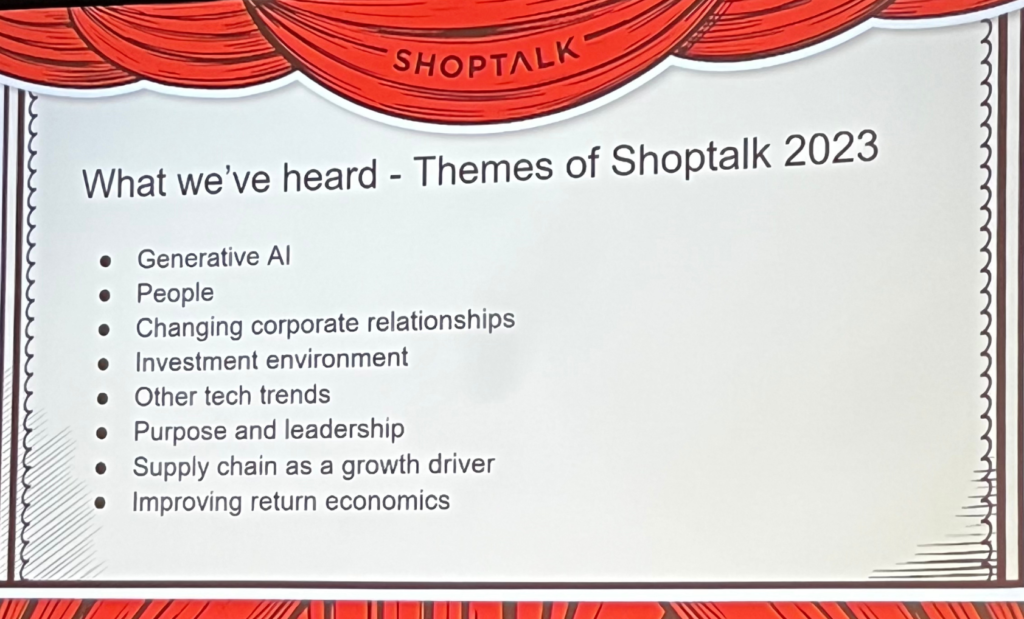An Annual Gathering of Retail Thought Leaders and Experts
This year, Shoptalk gathered 10,000+ attendees, including retailers and industry leaders to discuss growing trends and impactful technology that is shaping the future of retail. Shoptalk took place at Mandalay Bay in Las Vegas and included panels, workshops, roundtables, and networking opportunities. In this blog, we have compiled a list of the takeaways from Shoptalk that retailers should watch for 2023 and beyond.
Consumer Demand for Ambient Retail
As retailers aim to entice customers back into physical stores post-pandemic, they are getting more innovative with their approach to shopping. Ambient retail is quickly gaining traction in the retail industry, and consumers are happily embracing it. Ambient retail is about blending the physical and digital worlds to create a holistic shopping experience for consumers. In an ambient retail environment, technology is embedded in everyday objects, making it effortless for customers to interact with products and the store environment. Consumers no longer have to stand in long lines or search for items in a maze of shelves. Instead, they can simply pick up the product they want and walk out of the store. This approach has proven to be particularly popular among younger generations who prioritize convenience and efficiency. Retailers that can create ambient retail experiences will have a significant competitive advantage in the industry.
The Role of Friction in Reinforcing Brand Values
Maintaining the right amount of friction in the shopping journey is a delicate balance. While too much friction in a buyer’s journey can reduce conversions, removing all friction can make a brand appear cold and disingenuous. Retailers should embrace friction to reinforce their brand’s values and connect with customers. In Europe, some retailers are embracing slow checkouts to give cashiers and customers time to connect and build brand loyalty. Retailers can use friction points in the checkout, returns, and product discovery processes to stand out among competitors. By intentionally incorporating friction into these processes, retailers can develop a unique experience that fosters a sense of connection with customers. Ultimately, striking the right balance between friction and efficiency is key to delivering a shopping experience that is both memorable and enjoyable for customers.
Using A Customer-First Approach to Handle Retail Friction
In order to successfully navigate friction, brands need to reevaluate their approach. Handling opportunities that benefit the customer requires a diverse skill set that can integrate multi-functional solutions. Retailers cannot approach problems with a focus on merchandising or technology. Instead, they need to consider the entire ecosystem and how it impacts the end user. Helping is the new selling. A customer-first approach requires retailers to approach problems with empathy, actively seeking out opportunities to assist customers in a way that benefits the shopper, even if it may not immediately benefit the retailer. Retailers can use technology to provide proactive, personalized support, as well as streamline processes to reduce unnecessary friction points. By prioritizing the needs of their customers, retailers build trust, foster loyalty, and create a memorable and enjoyable experience for shoppers.
Positive Returns Processes Foster Customer Loyalty
In today’s retail landscape, a proper returns process has become an integral part of building customer loyalty. Retailers who exceed customer expectations through their returns process can foster personal connections with their shoppers. A successful returns strategy should adapt to consumer wants. Just as the introduction of BOPIS became crucial during the pandemic, consumers now want options such as BORIS (Buy Online, Return In-Store) during their returns process. By embracing technology, retailers can create a streamlined and efficient returns process that satisfies customer needs and builds brand loyalty. It is no longer enough to offer a return policy that simply satisfies requirements. A positive returns experience can make all the difference when it comes to retaining customers and fostering long-term relationships with them.
AI Isn’t Leaving The Retail Industry
As many retail leaders know, AI is rapidly becoming a key part of retail strategies. From conversational chatbots and hyper-personalized product recommendations to fraud protection and more, AI was a popular topic at Shoptalk. Retailers should embrace AI and machine learning (ML) instead of shying away. Retailers can use AI to personalize the customer experience by providing personalized product recommendations, promotions, and targeted marketing campaigns. Additionally, AI can help retailers automate mundane tasks. This allows employees to focus on higher-value activities such as customer service and strategic planning. Retailers can also use AI to optimize their supply chain management, improve inventory management, and reduce costs. Overall, embracing the future of AI can help retailers streamline their operations, reduce costs, and provide a better experience for their customers, making it a valuable tool for retailers.

In conclusion, Shoptalk 2023 was an amazing experience to take part in. The takeaway themes seem throughout Shoptalk of AI, ambient retail experiences, embracing friction, and leveraging returns to build loyal customers are critical for retailers to consider as they look to stay competitive and deliver on their brand value propositions. Retailers can achieve exceptional customer experiences and thrive in an ever-growing competitive retail industry by utilizing a combination of appropriate technology, business strategies, and organizational frameworks.
